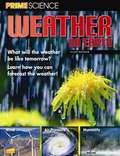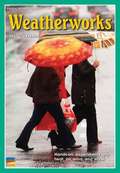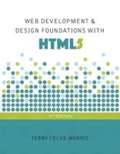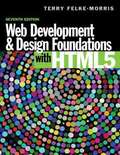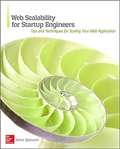- Table View
- List View
Weather and Climate Science
by Glencoe Mcgraw-HillThis series brings together both the underpinning principles and new developments in meteorology for students, as well as being a useful resource for the professional meteorologist or Earth system scientist.
Weather and Climate Systems
by Carolina Biological Supply Company Smithsonian Science Education CenterNIMAC-sourced textbook
Weather and Climate Systems Student Guide and Source Book (STC Science and Technology Concepts Middle School)
by Smithsonian Science Education Center StaffGrades 6–8. This Student Guide and Source Book provides the student investigations, student goals and objectives, and reading selections for the Weather and Climate Systems unit.
Weather and Climate: Establishing an Orangutan Reserve
by The Lawrence Hall of ScienceNIMAC-sourced textbook
Weather and Climate: Establishing an Orangutan Reserve, Investigation Notebook (Amplify Science)
by The Lawrence Hall of ScienceNIMAC-sourced textbook
Weather and Seasons
by Lawrence Hall of Science University of California at BerkeleyNIMAC-sourced textbook
Weather and Water
by Lawrence Hall of Science University of California at BerkeleyNIMAC-sourced textbook
Weather and Water Resources
by University of California at Berkeley Lawrence Hall of ScienceNIMAC-sourced textbook
Weather and Water Resources: Images, Data and Readings
by Associates FOSS Middle School Project StaffThe book presents the weather and water resources around the world with images and related data and readings.
Weather and the Sun (Inspire Science, Grade K #Unit 3)
by McGraw-Hill EducationNIMAC-sourced textbook
Weather of the San Francisco Bay Region (2nd edition)
by Harold GilliamAn introduction to the many factors which contribute to the unique weather of the San Francisco Bay region.
Weather on Earth
by Brett Kelly Hilary MaybaumFrom temperature to humidity to winds, this book tells you what you need to know about weather. You'll find out what causes weather, how and why it changes, and on what weather predictions are based. Learn how to interpret weather data and make your own weather forecasts! (Set of 10)
Weather on Earth
by Lawrence Hall of Science University of California at BerkeleyNIMAC-sourced textbook
Weather to Remember (Reach Into Phonics Ser.)
by Deborah J. Short Dee Wallis Malik PatelNIMAC-sourced textbook
Weatherworks
by Jeri Cipriano Nancy WhiteFind out about the components of weather by conducting experiments on air pressure, evaporation, condensation, and humidity. (Set of 6 with Teacher's Guide and Comprehension Question Card)
Web Development And Design Foundations With HTML5 (Eighth Edition)
by Terry Felke-MorrisUpdated and expanded in this Eighth Edition, Web Development and Design Foundations with HTML5 presents a comprehensive introduction to the development of effective web sites. Intended for beginning web developers, the text relates both the necessary hard skills (such as HTML5, CSS, and JavaScript) and soft skills (design, e-commerce, and promotion strategies) considered fundamental to contemporary web development. An emphasis on hands-on practice guides readers, as the text introduces topics ranging from configuration and layout to accessibility techniques and ethical considerations. The Eighth Edition contains updated coverage of HTML5 and CSS, expanded coverage of designing for mobile devices, and more.
Web Development And Design Foundations With Html5 Seventh Edition
by Terry Felke-MorrisWeb Development and Design Foundations with HTML5 is intended for use in a beginning web development course. It is also suitable for all readers interested in developing web sites. Using Hands-On Practice exercises and Web Site Case Studies to motivate readers, Web Development and Design Foundations with HTML5 includes all the necessary lessons to guide students in developing highly effective Web sites. A well-rounded balance of hard skills (HTML5, CSS, JavaScript) and soft skills (Web Design, e-commerce, Web site promotion strategies) presents everything beginning Web developers need to know to build and promote successful Web sites. Teaching and Learning Experience This program will provide a better teaching and learning experience-for you and your students. It will help: Build a Strong Foundation of Web Development Skills: A well-rounded foundation of hard and soft skills will help students design web pages for today and tomorrow. Motivate Students with Hands-on Practice: This text emphasizes hands-on practice through practice exercises within the chapters, end-of-chapter exercises, and the development of websites through ongoing real-world case studies. Reinforce Concepts with In-text Features: Throughout the book, emphasis is placed on web design, accessibility, and ethics. The appendixes in the Web Developer's Handbook offer comprehensive, easy-to-use reference materials Enhance Learning with Instructor and Student Supplements: Resources are available to expand on the topics presented in the text.
Web Scalability for Startup Engineers
by Artur EjsmontThis is an invaluable roadmap for meeting the rapid demand to deliver scalable applications in a startup environment. With a focus on core concepts and best practices rather than on individual languages, platforms, or technologies, Web Scalability for Startup Engineers describes how infrastructure and software architecture work together to support a scalable environment. <p><p> You’ll learn, step by step, how scalable systems work and how to solve common challenges. Helpful diagrams are included throughout, and real-world examples illustrate the concepts presented. Even if you have limited time and resources, you can successfully develop and deliver robust, scalable web applications with help from this practical guide. <p><p> Learn the key principles of good software design required for scalable systems Build the front-end layer to sustain the highest levels of concurrency and request rates Design and develop web services, including REST-ful APIs; Enable a horizontally scalable data layer Implement caching best practices; Leverage asynchronous processing, messaging, and event-driven architecture; Structure, index, and store data for optimized search; Explore other aspects of scalability, such as automation, project management, and agile teams.

